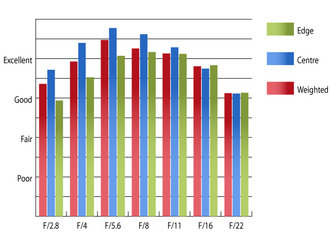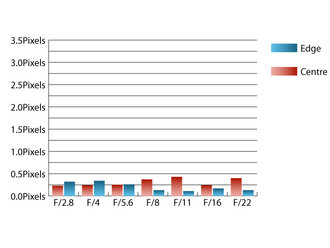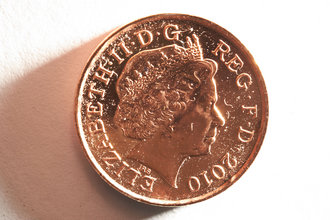Nikon 60mm f/2.8G ED AF-S Macro Nikkor Review
Nikon 60mm f/2.8G ED AF-S Macro Nikkor Performance
At maximum aperture, the lens already produces images with very good sharpness in the centre on the frame, with the quality towards the edges approaching good levels.Stopping the lens down improves quality across the frame until f/5.6, where the sharpness in the centre is outstanding and the clarity towards the edges of the frame is excellent. At smaller apertures, diffraction reduces resolution across the frame, but results are still good at f/22.
 MTF at 60mm | How to read our chartsThe blue column represents readings from the centre of the picture frame at the various apertures and the green is from the edges. Averaging them out gives the red weighted column.The scale on the left side is an indication of actual image resolution. The taller the column, the better the lens performance. Simple. For this review, the lens was tested on a Nikon D700 using Imatest. |
Chromatic aberrations are extremely well controlled at all apertures and across the entire image area. At its very worst fringing just exceeds 0.4 pixel widths in the centre of the frame at apertures smaller than f/11. This low level of fringing should be virtually invisible, even in large prints.
 Chromatic Aberrations at 60mm | How to read our chartsChromatic aberration is the lens' inability to focus on the sensor or film all colours of visible light at the same point. Severe chromatic aberration gives a noticeable fringing or a halo effect around sharp edges within the picture. It can be cured in software.Apochromatic lenses have special lens elements (aspheric, extra-low dispersion etc) to minimize the problem, hence they usually cost more. For this review, the lens was tested on a Nikon D700 using Imatest. |
Falloff of illumination towards the corners with this lens may be an issue for some photographers. At f/2.8 falloff is very pronounced on full frame, with the corners being 3.3 stops darker than the image centre. Visually uniform illumination isn't achieved until the lens is stopped down to between f/5.6 and f/8.
As might be expected from a fixed focal length lens, distortion is very well corrected. Imatest detected 0.439% barrel distortion, which is a very slight amount. If your application requires completely straight lines, this low level of distortion will be very straightforward to correct in image editing software afterwards, as the distortion pattern is consistent across the frame.
Nikon's Nano Crystal coating does an excellent job of reducing flare and retaining contrast, even in harshly contra-lit situations. The deep circular hood also does an excellent job of shading the front element, although it may need to be removed at close working distances to prevent it shading your subject.
Add your message
Login required
Please login here or if you've not registered, you can register here. Registering is safe, quick and free.
Please login here or if you've not registered, you can register here. Registering is safe, quick and free.
photodo Stats
1102 lenses
428 MTF tests
74 in-depth photodo reviews
100+ users join each day
Help the lens community by reviewing or rating a lens today via our lens search
428 MTF tests
74 in-depth photodo reviews
100+ users join each day
Help the lens community by reviewing or rating a lens today via our lens search
Latest Lens Reviews
- Chinon 28mm f/2.8 Vintage Lens Review
- Canon EF 70-200mm f/4L IS II USM Lens Review
- Samyang AF 85mm f/1.4 EF Review
- Sigma 70mm f/2.8 DG Macro Art Review
- Samyang AF 24mm f/2.8 FE Review
- Meike 50mm f/1.7 Review
- Tamron 70-210mm f/4 Di VC USD Review
- Lensbaby Burnside 35mm f/2.8 Review
- Asahi Super Takumar 50mm f/1.4 Review
- Asahi Super-Multi-Coated Takumar 135mm f/3.5 Review








